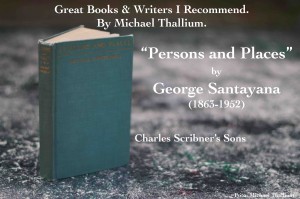 I am writing these lines while I am listening to Musica Ficta perform the Requiem by Tomas Luis de Victoria. I chose this music for practical reasons. Victoria was born in the province of Avila. He was a catholic priest and arguably the greatest Spanish composer of all times; he spent part of his life in Rome and died in Madrid in 1611. He became a choirboy at Avila Cathedral were he was trained as a musician before leaving for Rome, where he masterfully wrote the greatest music. So, what? What are those practical reasons? Let me first tell you that it is not Tomas Luis de Victoria the one I want to write about, but another man born over 250 years after Victoria’s death: George Santayana. So… what? What is still practical about your reasons? Well, Santayana was born in Madrid and spent his early childhood in Avila before moving to the United States, where he became a philosopher, an essayist, a poet and a novelist. So, what? Santayana loved cathedrals and died in Rome. Can you connect the dots? Madrid, Avila, Rome…
I am writing these lines while I am listening to Musica Ficta perform the Requiem by Tomas Luis de Victoria. I chose this music for practical reasons. Victoria was born in the province of Avila. He was a catholic priest and arguably the greatest Spanish composer of all times; he spent part of his life in Rome and died in Madrid in 1611. He became a choirboy at Avila Cathedral were he was trained as a musician before leaving for Rome, where he masterfully wrote the greatest music. So, what? What are those practical reasons? Let me first tell you that it is not Tomas Luis de Victoria the one I want to write about, but another man born over 250 years after Victoria’s death: George Santayana. So… what? What is still practical about your reasons? Well, Santayana was born in Madrid and spent his early childhood in Avila before moving to the United States, where he became a philosopher, an essayist, a poet and a novelist. So, what? Santayana loved cathedrals and died in Rome. Can you connect the dots? Madrid, Avila, Rome…
I think I should first explain how I came across George Santayana —quite a chance encounter by the way—, whom I had never heard of in my life. Of course, since he died in 1952, I do not mean I met him personally unless I were dead —knock on wood!— and had that strange power of coming back to life from the afterworld. No, my encounter with him was a bit more intelectual than physical. It was reading Invitation to Philosophizing Following The Spirit and Writings of Antonio Machado (“Invitación a filosofar según espíritu y letra de Antonio Machado”) by Juan David García Bacca —another Spanish philosopher— that I read the name “Jorge Santayana”. It caught my attention, because I had never heard of him before, and my attention turned into curiosity when I found out about him and got to know that Santayana had written all of his books in English. Actually, he changed the Spanish name “Jorge” —roughly pronounced ‘Horhey’— by “George” and he is considered one of the greatest American writers of the 20th century. However, he always remained Spanish. That was striking to me! Was it possible that a Spanish born in 1863 would turn into an American man of letters? After a little research I did, I manage to buy one of his books, Persons and Places, at Menosdiez, a little second-hand bookshop in Madrid downtown. I wanted to try and see whether he really was such a great writer as they said. Santayana had been a nominee to the Pulitzer Prize for his novel The Last Puritan (1936), but he was never awarded with the prize, apparently because he was not an American citizen and had always kept his Spanish passport.
And what a great writer he is indeed! I loved Persons and Places, an autobiography written at his late 70s where he beautifully describes an amazing life of academical achievements, travelling and philosophy. The book is divided up into sixteen chapters where he speaks about his origins in Spain, his teenage years in Boston, his achievements at Harvard University as an adult and his later return to Europe when he quit Harvard at age 48.
George Santayana may be the writer —not only prose but poetry as well, see A poet’s testament and O World— who best wrote about Spain in English. And for sure reading Persons and Places is a great exercise for those of us who want to master the English language and the knowledge about life in the late 19th and early 20th centuries in the United States, Spain and Europe. In all that regards himself, his thoughts, or his happiness, Santayana crossed a desert more than once in his life; so that when he looks back over those years, he sees objects, he sees public events, he sees persons and places, but he doesn’t see himself. His inner life, as he recalls it, seems to be concentrated in a few oases, in a few halting places, Green Inns, or Sanctuaries, where the busy traveller stopped to rest, to think, and to be himself. Now you may understand the practical reasons why I chose the music of Victoria while I was writing these lines. If you don’t, don’t worry, maybe someday you too will connect the dots.
Michael Thallium
Global & Greatness Coach
Book your coaching here
You can also find me and connect with me on:
Facebook Michael Thallium and Twitter Michael Thallium
